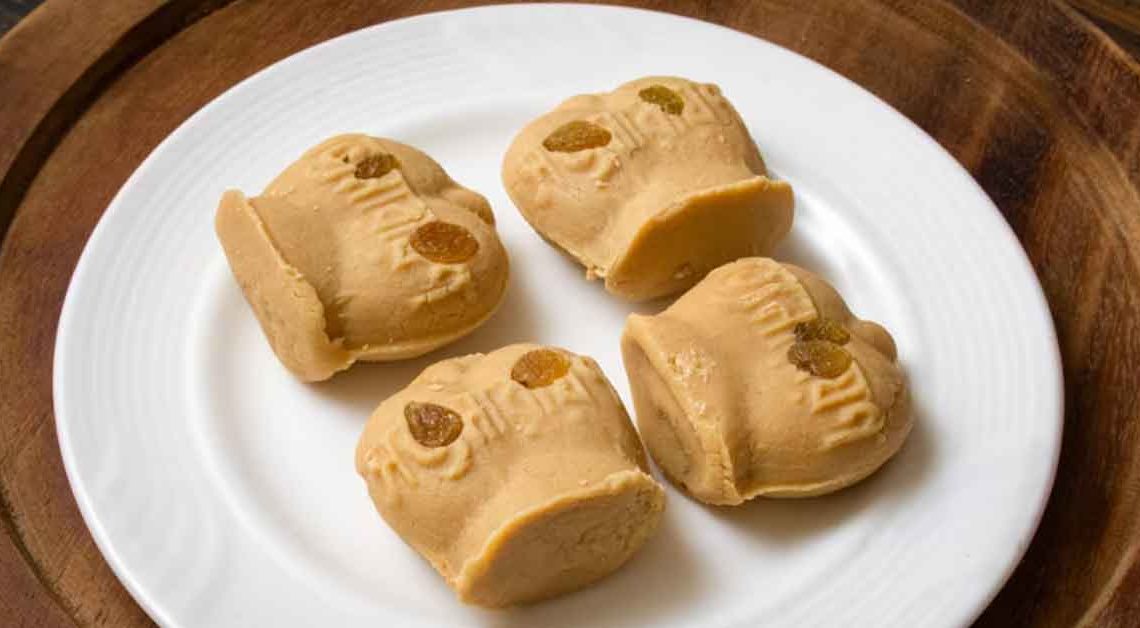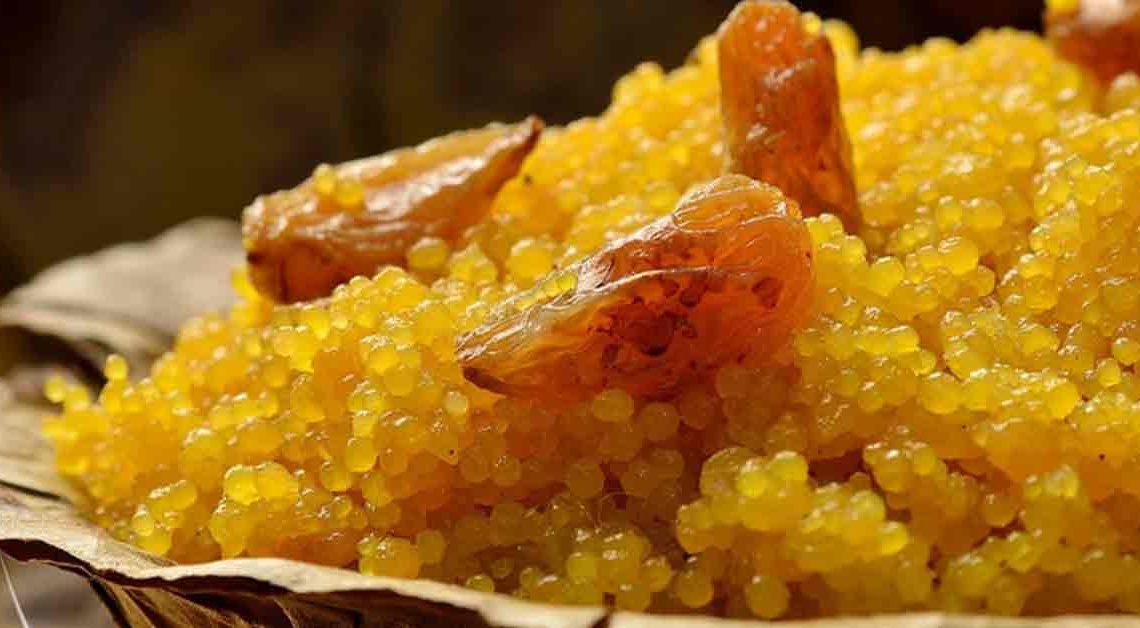A Sweet Escape: Jolbhora Korapak

Welcome to our culinary journey through the vibrant streets of Bengal on Mithainama, where every dish tells a story of tradition and flavor. Today, we delve into the delectable world of Jolbhora Korapak, a sweet that embodies the essence of Bengal’s rich culinary heritage.
Originating from the heart of Bengal, Jolbhora Korapak is a sweet treat that delights both the palate and the soul. Its name, translating to “filled with water,” hints at the tantalizing surprise that lies within. Picture a golden, crispy outer layer giving way to a burst of sweet, aromatic syrup, creating a symphony of textures and flavors that dance on your taste buds.
This sweet delicacy is not just a dessert; it’s a celebration of Bengal’s culinary artistry and love for sweets. Made with flour, sugar, and a hint of cardamom, each bite is a journey through the cultural tapestry of Bengal, where every ingredient tells a story of tradition and culinary craftsmanship passed down through generations.
It is more than just a sweet; it’s a cultural emblem that embodies the essence of Bengal’s rich culinary heritage.
Origin of Jolbhora Korapak
Jolbhora Korapak, a beloved sweet from Bengal, has its roots deeply embedded in the region’s culinary history and cultural traditions. It can be traced back to the rich tradition of sweet-making in Bengal, where sweets hold a special significance in various festivals, celebrations, and everyday life.
The exact origin is not well-documented, but it is believed to have originated in rural Bengal, where local cooks and sweet-makers experimented with different ingredients and techniques to create new and innovative sweets. Over time, it also became a popular sweet across Bengal, loved for its unique combination of crispy texture and sweet syrup filling.
The name “Jolbhora Korapak” itself reflects the essence of the sweet. “Jolbhora” means “filled with water,” referring to the syrupy filling inside the crispy outer layer, while “Korapak” likely refers to the crispy texture of the sweet.
History of Jolbhora Korapak
The history is deeply intertwined with the culinary traditions of Bengal, dating back to ancient times. While exact historical records are scarce, the sweet’s evolution can be traced through its ingredients and preparation methods, reflecting the cultural and social changes of the region.
Bengal has a long tradition of sweet-making, influenced by various cultures and communities that have inhabited the region over the centuries. The use of ingredients such as flour, sugar, and cardamom suggests a fusion of indigenous and foreign culinary influences.
It may have originated as a variation of another popular Bengali sweet, with the addition of a syrupy filling to create a unique texture and flavor profile. Over time, it became a staple in Bengali households and a favorite during festivals and celebrations.
The name “Jolbhora” likely refers to the sweet’s characteristic syrup-filled center, while “Korapak” may relate to its crispy outer layer. This combination of textures is a hallmark of Jolbhora Korapak and sets it apart from other sweets in Bengal’s culinary repertoire.
Cultural Significance
It holds a significant place in Bengali culture, serving as more than just a sweet treat but also as a symbol of tradition, celebration, and community.
Festivals and Celebrations: In Bengal, sweets play a central role in various festivals and celebrations, symbolizing joy, prosperity, and togetherness. It is often prepared and shared during festivals like Durga Puja, Diwali, and weddings, adding sweetness to these special occasions and strengthening social bonds.
Culinary Heritage: As a part of Bengal’s rich culinary heritage, it represents the ingenuity and creativity of Bengali sweet-makers. Its unique combination of textures and flavors reflects the region’s diverse cultural influences and culinary traditions passed down through generations.
Symbol of Hospitality: Offering sweets to guests is a common practice in Bengali culture, and is often included in the assortment of sweets served to visitors. It symbolizes hospitality, warmth, and generosity, welcoming guests into the home with a taste of Bengal’s culinary delights.
Where is Jolbhora Korapak Famous?
It is primarily famous in the Indian state of West Bengal, where it holds a special place in the hearts and palates of the people. It is especially popular in Bengali households, where it is enjoyed during festivals, celebrations, and as a sweet indulgence in everyday life.
It is famous in both urban and rural areas, with sweet shops and confectioneries across the state offering their own versions of this beloved treat. It is also commonly prepared at home, passed down through generations as a cherished family recipe.
It may be less widely known but can still be found in regions with a significant Bengali population or areas where Bengali cuisine is celebrated. In cities with a large Bengali diaspora, such as Kolkata, Delhi, Mumbai, and Dhaka, Jolbhora Korapak may be available in specialty sweet shops catering to Bengali tastes.
Interesting Facts and Trivia
Here are some interesting facts and trivia related to Jolbhora Korapak:
- While the basic concept of Jolbhora Korapak remains the same—a crispy outer layer filled with syrup—there are regional variations in its preparation across Bengal. Different regions may use slightly different ingredients or techniques to make this sweet, adding their own unique touch to the dish.
- It is not a recent invention but has been a part of Bengali cuisine for centuries. However, historical references specifically mentioning this sweet are scarce, making it difficult to pinpoint its exact origin or early history.
- Traditionally, it was made during the winter months in Bengal, especially during the Poush Parbon festival. This festival, celebrating the winter harvest, is a time when various sweet dishes are prepared using freshly harvested ingredients.
- The concept of filling a crispy shell with syrupy filling is not unique to Jolbhora Korapak. Similar sweets can be found in other cuisines around the world, showcasing the universal appeal of this delightful combination of textures and flavors.
- In Bengali literature and poetry, sweets are often used as metaphors to describe the sweetness of life, love, and relationships. They symbolize the joy and richness of Bengali culture and tradition.
Did You Know?
Did you know? Consuming Jolbhora Korapak, a traditional sweet from Bengal, not only delights the taste buds but also offers potential health benefits:
- The combination of carbohydrates from the flour and sugars in Jolbhora Korapak provides a quick energy boost, making it a perfect treat to enjoy during festivals or as a midday snack.
- While primarily a treat, it contains ingredients like cardamom, which is rich in antioxidants and may have digestive benefits. Additionally, the use of ghee or clarified butter in its preparation adds a source of healthy fats.
- Sweets like this delectable dessert can trigger the release of serotonin in the brain, promoting feelings of happiness and satisfaction. Enjoying this sweet in moderation may contribute to a positive mood and overall well-being.
- Sharing with family and friends fosters social connections and strengthens bonds, contributing to emotional well-being and a sense of belonging within the community.
- While it offers potential health benefits, it should be enjoyed in moderation as part of a balanced diet. Excessive consumption of sweets can contribute to health issues such as weight gain and dental problems.







